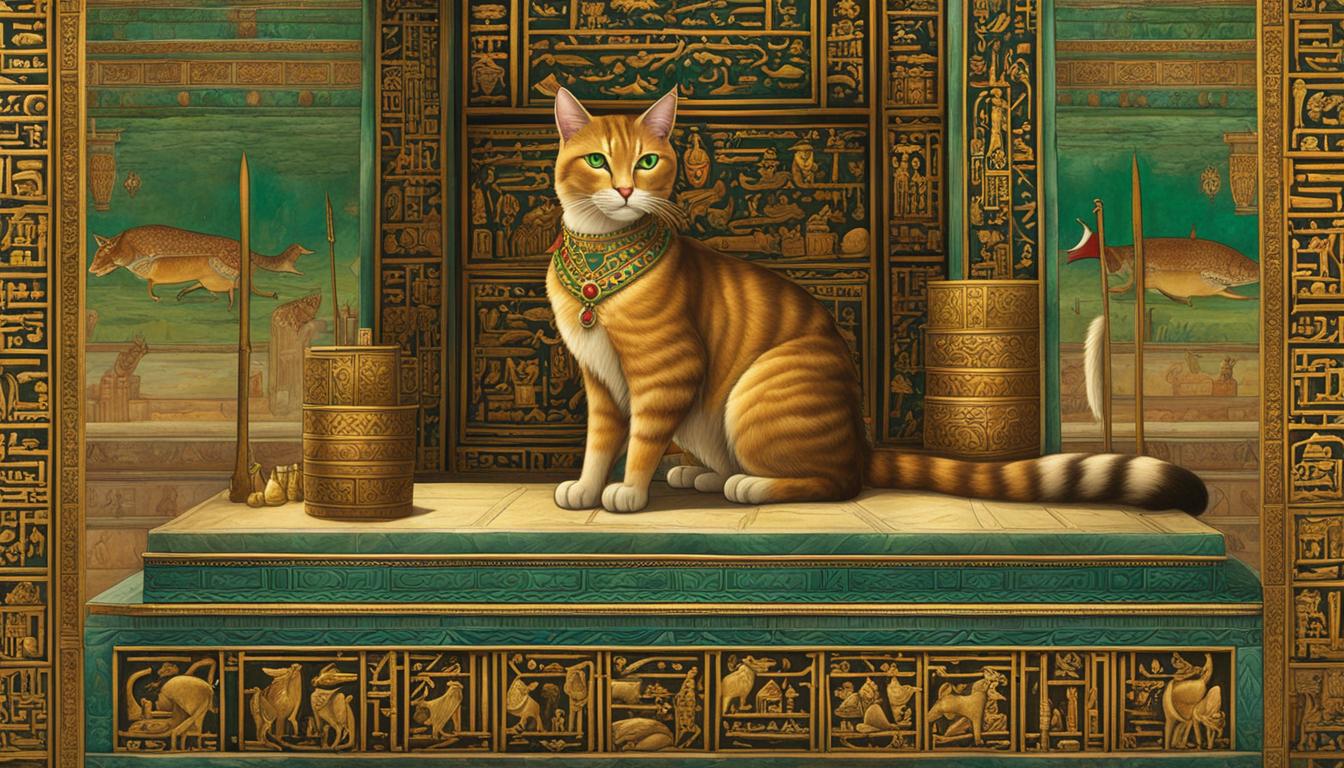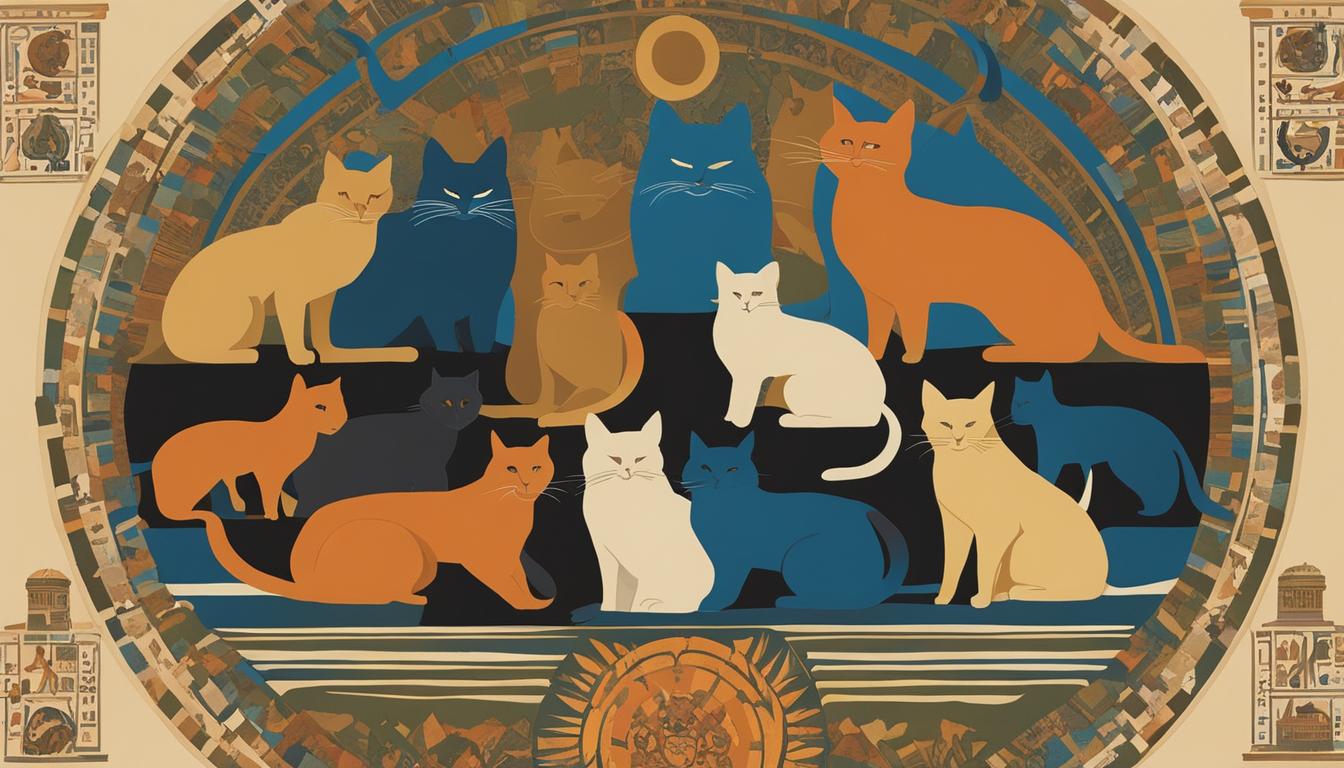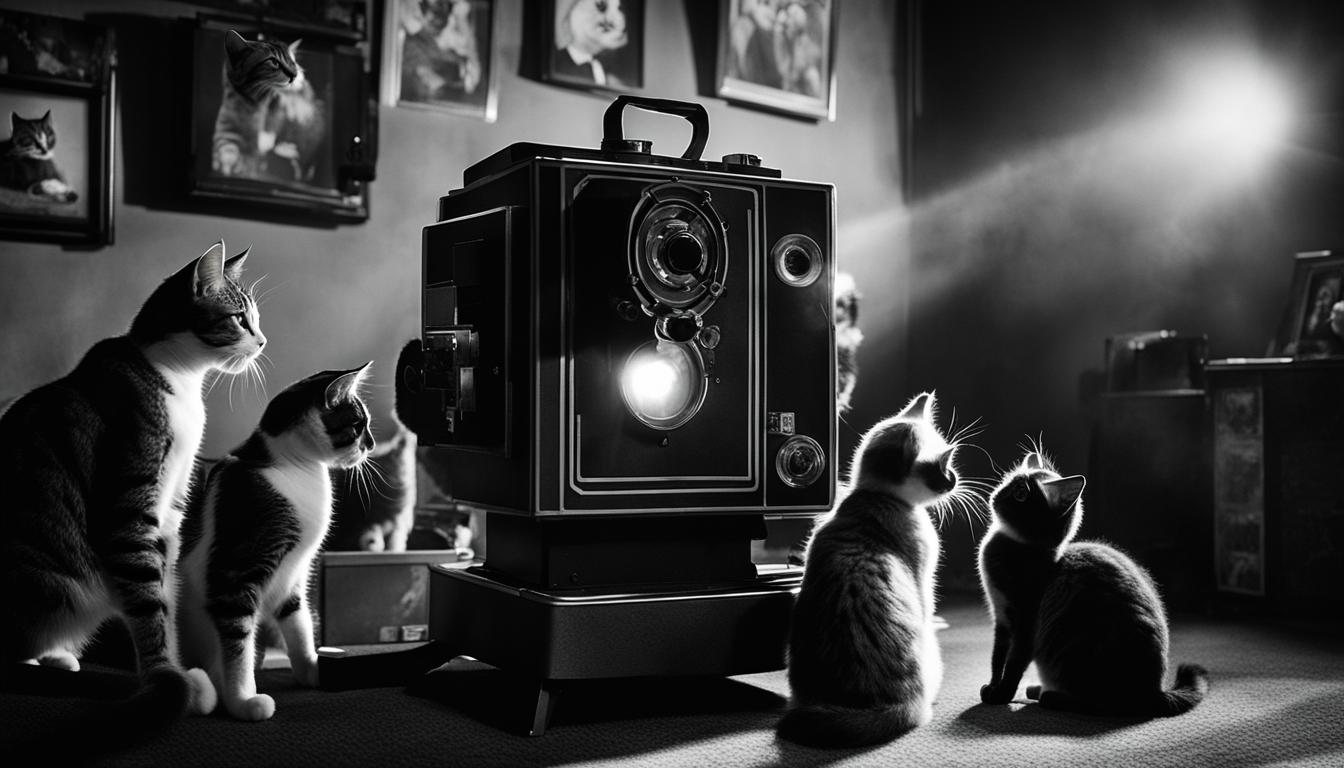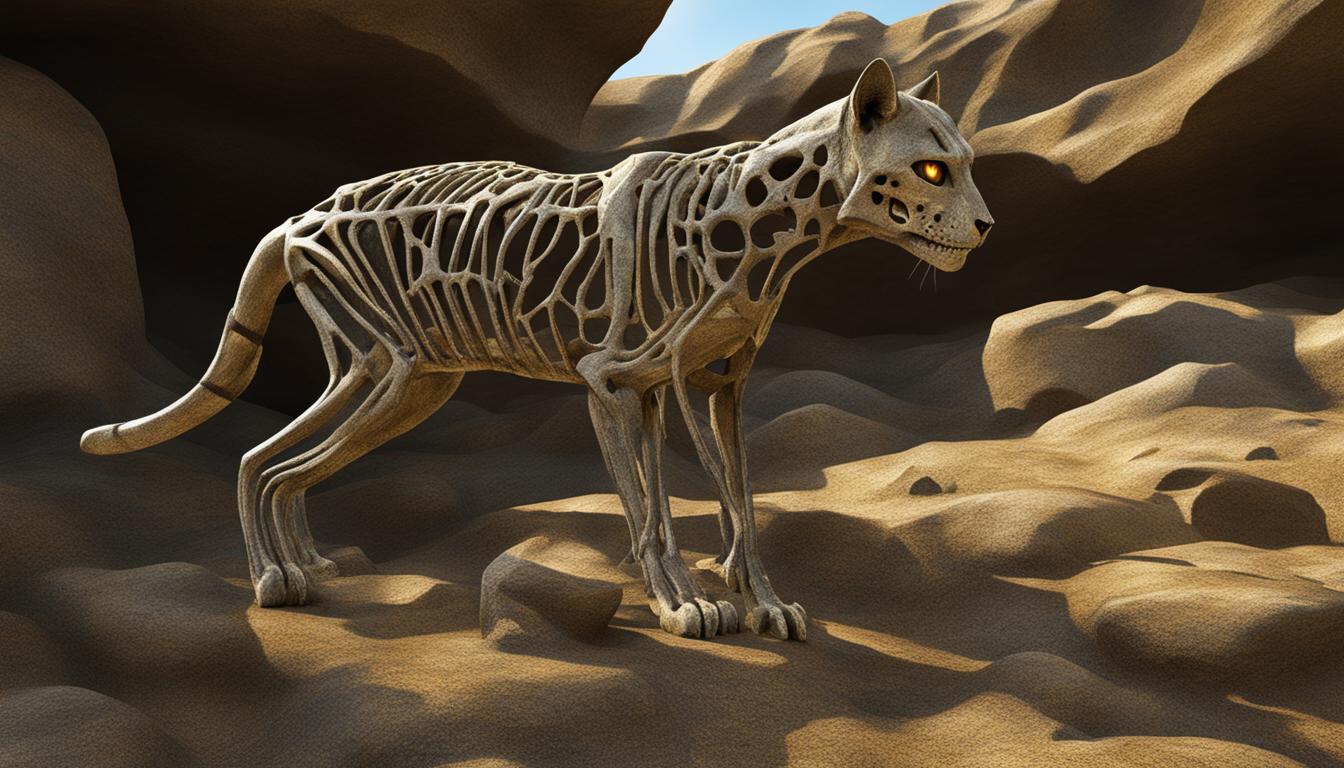Hey there, fellow feline enthusiasts! Today, I want to whisk you away to the mystical land of Ancient Egypt, where cats reigned supreme. Join me on this fascinating journey as we explore the worship of cats in ancient Egypt and discover why these magnificent creatures were considered sacred animals.
Picture this: wealthy families adorning their majestic feline companions with dazzling jewels, treating them like royalty. It’s no wonder the Ancient Egyptians believed in the magical and lucky qualities of cats. These captivating creatures were revered for their grace, elegance, and uncanny ability to bring good fortune to their human counterparts.
In fact, the bond between cats and their Egyptian owners was so profound that when these regal felines passed away, their mourning humans would go to great lengths to honor their memory. They would shave off their eyebrows as a sign of grief and respect.
But it didn’t stop there. The city of Per-Bast boasted a magnificent temple dedicated to the cat goddess Bastet, the only deity capable of transforming into a cat. Imagine the awe-inspiring rituals and celebrations held in her honor!
Now, before you think about messing with a cat in ancient Egypt, think again. Killing a cat was considered a serious crime, punishable by death. That’s how highly these majestic creatures were regarded in Egyptian society.
Key Takeaways:
- Ancient Egyptians worshipped cats for their belief in their magical and lucky qualities.
- Wealthy families adorned their cats with jewels and treated them like royalty.
- When cats died, their owners mourned by shaving off their eyebrows.
- The city of Per-Bast had a temple dedicated to the cat goddess Bastet.
- Killing a cat was considered a serious crime in ancient Egypt, punishable by death.
Cats in Egyptian Religion and Mythology
The ancient Egyptians held a deep reverence for cats, and this was especially evident in their religion and mythology. Cats were believed to possess divine qualities and were associated with several Egyptian deities. These feline gods and goddesses played significant roles in Egyptian society and were revered for their symbolic representations.
One of the prominent cat deities in Egyptian mythology was Bastet, also known as the cat goddess. Bastet was often depicted with the head of a lioness or a domestic cat, symbolizing her protective and nurturing qualities. She was associated with fertility, home, and joy. Another cat-like deity was Mafdet, who represented justice and was depicted as a lioness or cat.
“The goddess Bastet, with her feline grace and piercing gaze, embodied the fierce yet tender aspects of the cat. She was both a bringer of protection and a reminder of the delicate balance between life and death,” explains renowned Egyptologist Dr. Amelia Carter.
The ancient Egyptians believed that cats possessed the ability to ward off evil spirits and protect against venomous snakes, rodents, and birds that threatened their crops. This made cats essential for agricultural prosperity and ensured their elevated status in society. The Book of the Dead, a collection of ancient Egyptian funerary texts, also linked cats with the sun god Ra. The feline’s association with the sun highlighted its symbolic importance for sustaining life on Earth.
| Egyptian Cat Gods and Goddesses | Symbolic Meanings |
|---|---|
| Bastet | Protection, fertility, joy |
| Mafdet | Justice |
| Sekhmet | Power |
The significance of cats in Egyptian society is further evidenced by the popularity of cat-shaped decorations during the New Kingdom of Egypt. These decorative items reflected the widespread presence of domesticated cats in the daily lives of ancient Egyptians. Additionally, cat cemeteries at Speos Artemidos, Bubastis, and Saqqara served as resting places for countless cat mummies and statues, further emphasizing the profound connection between cats and the Egyptian people.
Cats in Ancient Egyptian Art and Symbolism
Ancient Egyptian art is renowned for its portrayal of cats, emphasizing their significance and revered status in society. Paintings and statues of cats adorned the walls of temples, tombs, and homes, highlighting their close connection to Egyptian culture and religion.
The Symbolism of Cats in Egyptian Art
Cats held a multifaceted symbolism in ancient Egyptian art. Their depiction often evoked ideas of fertility and femininity, as they were associated with the goddess Bastet, who represented love, motherhood, and protection. In many tomb scenes, cats can be seen nestled under chairs, a symbol of their role in ensuring prosperity and abundance.

“The ancient Egyptians believed that cats possessed magical qualities and brought good fortune to their owners. This belief was reflected in their art, where cats were depicted as graceful and powerful creatures, often adorned with jewelry or placed alongside symbols of royalty.”
Furthermore, cats played a significant role in the symbolism of hieroglyphs, the ancient Egyptian writing system. Cat hieroglyphs were used to represent protection and divine power, reinforcing the belief in their mystical qualities and their ability to ward off evil spirits.
Egyptian Cat Burial Customs
The reverence for cats extended to their burial customs. Just like humans, cats were mummified and placed in elaborate sarcophagi, preserving their bodies for eternity. Cat cemeteries, such as those found at Speos Artemidos, Bubastis, and Saqqara, contained vast numbers of cat mummies and statues, further emphasizing the importance of cats in Egyptian society.
| Cat Burial Customs | Significance |
|---|---|
| Mummification of Cats | Reflecting their importance in the afterlife |
| Elaborate Sarcophagi | Preserving their bodies for eternity |
| Cat Cemeteries | Containing vast numbers of cat mummies and statues |
The cat burial customs reveal the deep respect and reverence the ancient Egyptians had for these feline creatures, considering them worthy of the same treatment as their human counterparts in death.
Through their art and burial customs, the ancient Egyptians celebrated and immortalized the sacred role of cats in their society. These depictions and rituals continue to captivate our fascination, providing valuable insights into the cultural and religious beliefs of one of history’s most fascinating civilizations.
Cats in Ancient Egyptian Society
In ancient Egyptian society, cats held a revered and sacred role. They were not just domesticated pets but were also considered symbols of protection and good fortune. The presence of cat mummies in abundance suggests their significance in Egyptian rituals and burial customs.
The role of cats in Egyptian society extended beyond their physical presence. They were actively involved in various ceremonies and rituals, serving as symbols of divine protection. The Egyptians believed that cats possessed spiritual powers and could ward off evil spirits.
One of the most intriguing aspects of ancient Egyptian culture was their elaborate burial practices. Cats were mummified and buried alongside their human counterparts, reflecting their importance in the afterlife. The mummification process was carried out with great care, ensuring that the cat’s body was preserved for eternity.
The worship and reverence of cats in ancient Egypt continued for centuries, until the arrival of Christianity, which led to a decline in their veneration. However, in modern times, cats have regained their status as beloved companions and cultural icons, captivating our fascination with ancient Egypt and its rich history.
Egyptian Cat Mummies: A Fascinating Relic of the Past
One of the most captivating aspects of ancient Egyptian culture is the abundance of cat mummies that have been discovered. These cat mummies provide a fascinating glimpse into the deep-rooted reverence the Egyptians held for these animals.
The elaborate process of mummifying cats involved carefully preserving their bodies and wrapping them in linen bandages. The cat mummies were then placed in decorative coffins, often adorned with intricate carvings and symbols.
Why did the ancient Egyptians go to such great lengths to preserve their cats? It is believed that they considered their feline companions as sacred beings, capable of bringing luck and protection. By mummifying them, the Egyptians ensured that their cats would continue to enjoy these qualities in the afterlife.
The discovery of cat cemeteries, such as the ones at Speos Artemidos, Bubastis, and Saqqara, further emphasizes the prominent role of cats in ancient Egyptian society. These cemeteries are filled with an abundance of cat mummies, serving as a testament to the deep respect and reverence the Egyptians held for these animals.
The Role of Cats in Egyptian Rituals and Burial Customs
Throughout ancient Egyptian history, cats played a significant role in various rituals and burial customs. Due to their association with protection and good fortune, cats were often present during religious ceremonies.
The Egyptians believed that the presence of cats would help ward off evil spirits and bring blessings to the community. This belief led to the inclusion of cat figurines and statues in temples and homes. These artifacts served as a reminder of the cat’s protective qualities and their connection to the divine.
In burial customs, cats were mummified and buried alongside their owners or in dedicated cat cemeteries. This practice demonstrated the Egyptians’ belief in a connection between humans and their feline companions in the afterlife. These burials often involved elaborate rituals and ceremonies to ensure the safe passage of both humans and cats into the next realm.
The role of cats in Egyptian rituals and burial customs highlights their revered status in ancient Egyptian society. Their presence in these practices underscores the deep-rooted belief in their sacred qualities and the important role they played in the lives of the Egyptians.
| Egyptian Cat Mummies | Role in Rituals | Burial Customs |
|---|---|---|
| An abundance of cat mummies have been discovered, showcasing the deep reverence Egyptians held for these animals. | Cats were actively involved in various rituals and ceremonies, serving as symbols of protection and good fortune. | Cats were mummified and buried alongside their human counterparts, reflecting their importance in the afterlife. |
| The mummification process involved carefully preserving the cat’s body and wrapping it in linen bandages. | The presence of cats during religious ceremonies was believed to ward off evil spirits and bring blessings. | Cat mummies were often placed in decorative coffins, adorned with intricate carvings and symbols. |
| Discoveries of cat cemeteries further emphasize the prominent role of cats in ancient Egyptian society. | Cat artifacts, such as figurines and statues, were used as reminders of their protective qualities and divine connection. | Elaborate rituals and ceremonies were carried out to ensure the safe passage of both humans and cats into the afterlife. |
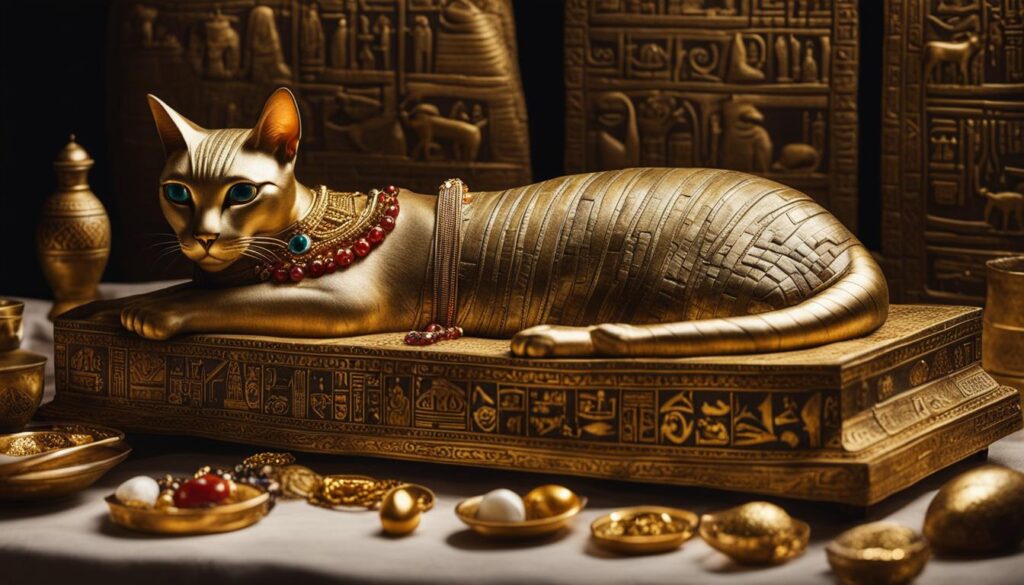
“The Egyptians believed that cats possessed spiritual powers and could ward off evil spirits.”
Conclusion
As I wrap up this fascinating journey into ancient Egypt’s love for cats, one thing becomes abundantly clear: the significance of cats in Egyptian society cannot be underestimated. These captivating creatures held a sacred role, embodying luck, protection, and divine qualities. From the glittering jewels adorning their regal feline bodies to the solemn rituals surrounding their burials, cats were cherished members of Egyptian households.
Their presence extended beyond the domestic realm, permeating every aspect of Egyptian culture. The gods and goddesses of ancient Egypt often took on feline forms, with Mafdet symbolizing justice, Bastet embodying fertility, and Sekhmet representing power. Cats were not just seen as earthly companions; they were revered as spiritual guardians, protecting against venomous snakes and crop-damaging pests.
Ancient Egyptian art and hieroglyphs beautifully captured the significance of cats. Paintings and statues depicted their regality, while cat-shaped decorations during the New Kingdom showcased their prominence in daily life. Cat hieroglyphs, symbols of protection and divine power, were intricately woven into Egyptian writing. These artifacts and symbols stand as testaments to the enduring fascination Egyptians had with their feline friends.
Though the veneration of cats waned with the arrival of Christianity, their legacy lives on. Today, we continue to cherish cats as beloved companions, their rich history forever intertwined with our own. As we marvel at ancient Egyptian cat artifacts, we can’t help but wonder at the profound impact these enchanting creatures had on a society that revered them for centuries.
FAQ
Why were cats considered sacred in ancient Egypt?
Ancient Egyptians believed that cats possessed magical and lucky qualities, and they were associated with various deities. Cats were revered for their ability to protect against harmful creatures and were seen as symbols of protection and good fortune.
How were cats treated in ancient Egypt?
Cats were highly valued and treated with great respect in ancient Egypt, especially by wealthy families. They were adorned with jewels, treated like royalty, and even mummified after death. The loss of a cat was mourned by shaving off eyebrows as a sign of grief.
Which goddess was associated with cats in ancient Egypt?
The cat goddess Bastet, also known as Bast, was especially significant in ancient Egyptian culture. She was believed to be the only deity capable of transforming into a cat and was associated with fertility, protection, and the sun.
What were the penalties for harming a cat in ancient Egypt?
Killing a cat in ancient Egypt was considered a serious crime and was punishable by death. The reverence for cats was so intense that harming them was seen as a direct offense to the gods and the well-being of the community.
How did cats influence Egyptian art and symbolism?
Cats played a prominent role in ancient Egyptian art, appearing in paintings and statues. They were often associated with fertility and femininity, symbolized by their presence under chairs in tomb scenes. Cat hieroglyphs were used as symbols of protection and divine power in Egyptian writing.
Did cats have a role in Egyptian burial customs?
Absolutely. Cats were mummified and placed in elaborate sarcophagi when they died. Cat cemeteries, such as those found at Speos Artemidos, Bubastis, and Saqqara, contained vast numbers of cat mummies and statues, reflecting their importance in the afterlife.
How are cats regarded in modern times?
Today, cats continue to be cherished as beloved companions and continue to captivate our fascination with ancient Egypt. Although the worship and reverence of cats declined with the arrival of Christianity, their sacred role in ancient Egyptian culture has left a lasting impact on our perception of these remarkable creatures.

